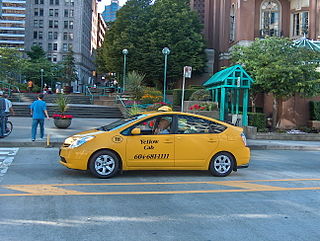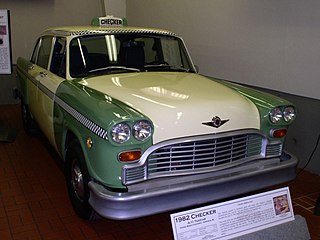
Yellow cab taxicab operators exist all around the world (some with common heritage, some without). The original Yellow Cab Company, based in Chicago, Illinois, was one of the largest taxicab companies in the United States.

Yellow cab taxicab operators exist all around the world (some with common heritage, some without). The original Yellow Cab Company, based in Chicago, Illinois, was one of the largest taxicab companies in the United States.

Yellow cabs date back to at least 1798, when the musical comedy, Cabriolet Jaune (Yellow Cab), debuted at Paris' Theatre de l'Opera Comique National. Yellow cabs were known in Paris and London throughout most of the 1800s. A yellow cab company shook up the New York Cab system in the mid-1880s, offering cheaper, more predictable fares than competitors. One of the first automobile cabs in London, in the 1890s, was a yellow electric automobile. [1]
The Yellow Cab Company of Chicago was founded by John D. Hertz in 1907. [2] Their specially designed taxicabs were powered by a 4-cylinder Continental engine equipped with a purpose-built taxicab body supplied by the Racine Body Co., of Racine, Wisconsin. [3] According to Yellow Cab Co. tradition, the color (and name) yellow was selected by John Hertz as the result of a survey he commissioned at a "local university", which indicated it was the easiest color to spot. [4] However, "he was certainly not the first taxicab operator to use that color and the university study to which B. C. Forbes refers has yet to be discovered." [5] In 2017, a study showed that the color yellow, for taxis, was more noticeable, resulting in 9% fewer accidents. [6]
In 1908, Albert Rockwell, founder and General Manager of the New Departure Manufacturing Co. of Bristol, Connecticut, travelled to Europe to evaluate their taxi systems, hoping to develop a similar one in Washington, D.C. [7] Ernest Wyckoff, Alfred Church and Clarence Partridge, well-known automobile dealers in New York, had a number of orange-yellow colored Rockwell taxicabs operating on Manhattan streets in 1909. [3] By March 1910, the Connecticut Cab Co. (essentially the directors of New Departure Manufacturing Co.) assumed operating control of Wyckoff, Church and Partridge's taxis. [8]
The Yellow Taxicab Co. was incorporated in New York on April 4, 1912. Its fares that year started at 50¢/mile (roughly equivalent to $12.12 in 2016 adjusted for inflation). [9] Among its directors and major stockholders were Albert Rockwell and the Connecticut Cab Co.[ citation needed ] Shortly after incorporation the Yellow Taxicab Co. merged with the Cab and Taxi Co., and with the strength of Connecticut Cab Co. behind them, the young business assumed a large share of the New York market. Its independent corporate life was fairly short, however, as fare wars and regulations forced a merger with the Mason-Seaman Transportation Co. on March 3, 1914. Shortly after, an injunction was filed by the company, seeking to restrain the city from enforcing the Public Hack ordinances, but it was rejected on appeal. [10] By 1916, the company was being held in receivership, due to suits by numerous creditors. [11]
The Yellow Cab Manufacturing Company was formed in 1920. [3]

Yellow cabs are the focus of the films The Yellow Cab Man (1950), starring Red Skelton, [29] [ better source needed ] and the acclaimed Taxi Driver (1976).

A hackney or hackney carriage is a carriage or car for hire. A hackney of a more expensive or high class was called a remise. A symbol of London and Britain, the black taxi is a common sight on the streets of London. The hackney carriages carry a roof sign TAXI that can be illuminated to indicate their availability for passengers.

Checker Motors Corporation was a Kalamazoo, Michigan, vehicle manufacturer and tier-one subcontractor that manufactured taxicabs used by Checker Taxi. Morris Markin established the company in 1922, initially named the Checker Cab Manufacturing Company, in Chicago through a merger of Commonwealth Motors and Markin Automobile Body. The manufacturer moved to Kalamazoo in 1923 and was renamed to Checker Motors in 1958.

The Yellow Cab Company was a taxicab company in Chicago which was founded in 1907 by John D. Hertz.

John Daniel Hertz Sr. was an American businessman, thoroughbred racehorse owner and breeder, and philanthropist.

In New York City, taxicabs come in two varieties: yellow and green; they are widely recognizable symbols of the city. Taxis painted yellow are able to pick up passengers anywhere in the five boroughs. Those painted apple green, which began to appear in August 2013, are allowed to pick up passengers in Upper Manhattan, the Bronx, Brooklyn, Queens, and Staten Island. Both types have the same fare structure. Taxicabs are operated by private companies and licensed by the New York City Taxi and Limousine Commission (TLC). It also oversees over 40,000 other for-hire vehicles, including "black cars", commuter vans, and ambulettes.

The Checker Marathon is an automobile produced by the Checker Motors Corporation of Kalamazoo, Michigan, between 1961 and 1982. It was marketed as a passenger car for consumers, as opposed to the similar Taxi, which was aimed at fleet buyers.
Taxicabs within a country often share common properties, but there is a wide variation from country to country in the vehicles used, the circumstances under which they may be hired and the regulatory regime to which these are subject.
The taxicabs of the United States make up a mature system; most U.S. cities have a licensing scheme which restricts the number of taxicabs allowed. As of 2012 the total number of taxi cab drivers in the United States is 233,900; the average annual salary of a taxi cab driver is $22,820 and the expected percent job increase over the next 10 years is 16%.
Illegal taxicabs, sometimes known as pirate taxis, gypsy cabs, or jitney cabs, are taxicabs and other for-hire vehicles that are not duly licensed or permitted by the jurisdiction in which they operate. Most major cities worldwide require taxicabs to be licensed, safety-inspected, insured as for-hire vehicles, and to use taximeters, and there may also be requirements that the taxi driver be registered or accredited. However, many unlicensed cabs are in operation. Illegal cabs may be marked taxi vehicles, and others are personal vehicles used by an individual to offer unauthorized taxi-like services. Illegal cabs are prevalent in cities with medallion systems, which restrict the number of legal cabs in operation. Since their introduction in 2009, vehicles affiliated with the transportation network company Uber have been classified as illegal taxicabs in some jurisdictions.

A taxi, also known as a taxicab or simply a cab, is a type of vehicle for hire with a driver, used by a single passenger or small group of passengers, often for a non-shared ride. A taxicab conveys passengers between locations of their choice. This differs from public transport where the pick-up and drop-off locations are decided by the service provider, not by the customers, although demand responsive transport and share taxis provide a hybrid bus/taxi mode.
Taxicabs and other vehicles-for-hire in Canada are regulated by local municipalities and provinces, and are owned & operated by private companies and individuals. Unlicensed cabs in some cities are referred to as bandit taxis/cabs.

Cars such as Toyota Etios, Maruti Omni, Mahindra Logan, Maruti Suzuki, Tata Indica and Tata Indigo are fairly popular among taxicab operators. The livery of the taxicabs in India varies from state to state. In Delhi and Maharashtra, most taxicabs have yellow-black livery, while in West Bengal, taxis have yellow livery. Private taxicab operators are not required to have a specific livery. However, they are required by law to be registered as commercial vehicles.

Hybrid taxi or hybrid electric taxi is a taxicab service provided with a hybrid electric car (HEV), which combines a conventional internal combustion engine propulsion system with an electric propulsion system.
Taxicabs of Venezuela is a form of public transport in Venezuela. At difference with most taxicab services in the world, in Venezuela there is not taximeter, nor any other form of measure the fare. The way it is measure is by a 'Carrera' which varies between driver. Due to this way of charging, it is a custom to ask and often negotiate the fare before getting inside the taxicab.

Checker Taxi was a dominant taxicab company and national franchisor that was based in Chicago, Illinois. Checker Motors was an American vehicle manufacturer based in Kalamazoo, Michigan that built the iconic Checker Taxicab, sold commercially as the Checker Marathon until 1982. Both companies were owned by Morris Markin by the 1930s.
Taxi livery varies greatly from country to country. In some countries, livery is determined by Government legislation, in other countries, taxi operators have choice on colours.

The Commonwealth Motors Corporation was a luxury auto company that produced cars from 1917 to 1922. The company was founded in Chicago as Partin-Palmer company in 1913, but in 1915 got into financial trouble. In 1917, the name was changed to Commonwealth, and production was moved to Joliet, Illinois.

The Vehicle Production Group LLC was an American automobile manufacturer. Based in Miami, Florida, it made the wheelchair-accessible taxicabs, the MV-1, which was built in Mishawaka, Indiana at an AM General plant.

Boro taxis are taxicabs in New York City that are allowed to pick up passengers in outer boroughs and in Manhattan above East 96th and West 110th Streets. The color of boro taxis is apple green in contrast to the traditional yellow taxis in New York City.

The Checker Cab Building was built as a garage and office building located at 2128 Trumbull Avenue in Detroit, Michigan. It was listed on the National Register of Historic Places in 2019. The building has been rehabilitated into residences, and is now part of the Elton Park lofts.